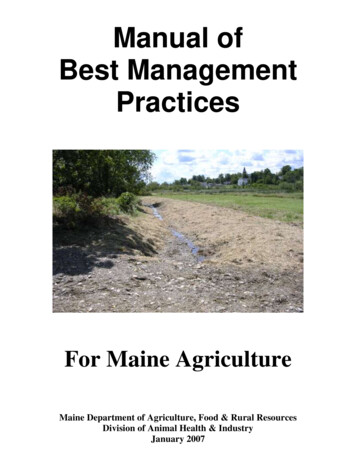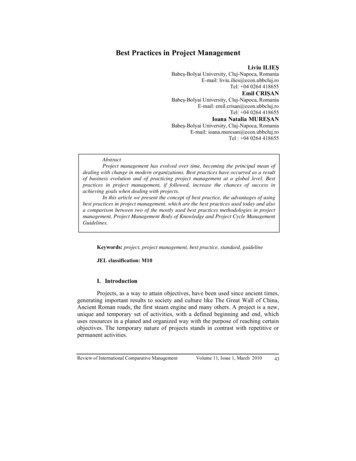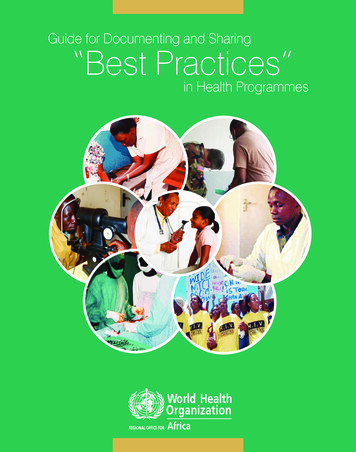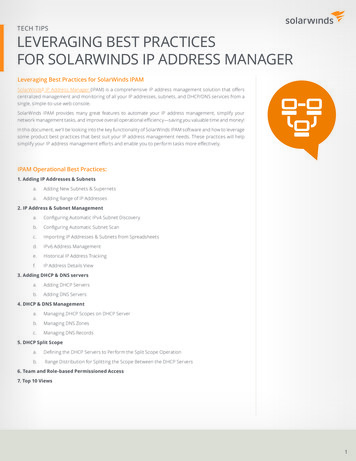
Transcription
Manual ofBest ManagementPracticesFor Maine AgricultureMaine Department of Agriculture, Food & Rural ResourcesDivision of Animal Health & IndustryJanuary 2007
Best Management Practices for Maine AgricultureAcknowledgementsThis Manual of Best Management Practices for Maine Agriculture, published in January2007, is the first comprehensive compilation of agriculture-related best managementpractices ever published in the State of Maine. It is a work that has been in progress formany years, and has reached completion through the efforts of many individuals. Theseindividuals either have written text for the Manual and/or contributed lists of potentialbest management practices for the Manual, or have reviewed its contents for clarity andtechnical accuracy. We acknowledge their contributions below:Principal AuthorsHugh M. CoxeMark F. HedrichNew England Planning Concepts, Yarmouth, MaineNutrient Management CoordinatorMaine Department of Agriculture, Food & Rural ResourcesMaine Department of Agriculture, Food & Rural ResourcesRobert BatteeseJonathan ChalmersShelley F. DoakGary FishClinton V. GiustraJohn HarkerDonald E. Hoenig, V.M.D.Craig LeonardPeter N. Mosher, Ph.D.David P. RocqueWilliam M. Seekins, Ph.D.Acting Director, Division of Plant IndustryAgricultural Compliance SupervisorDirector, Division of Animal Health & IndustryEnvironmental SpecialistLivestock Industry SpecialistAgricultural Resource Management SpecialistState VeterinarianAgricultural Compliance SupervisorDirector, Office of Agricultural, Natural & Rural ResourcesState Soil ScientistAgricultural Resource Management CoordinatorUSDA Natural Resources Conservation ServiceRandy DoakPaul HughesMary ThompsonDistrict ConservationistState Resource ConservationistDistrict Conservationisti
Best Management Practices for Maine AgricultureMaine Department of Environmental ProtectionMark A. KingNorm G. MarcotteDonald T. WitherillEnvironmental SpecialistEnvironmental SpecialistDirector, Division of Watershed ManagementAgricultural Industry SpecialistLauchlin W. TitusCertified Professional AgronomistUniversity of Maine Cooperative ExtensionMark HutchinsonRick KersbergenExtension Educator & ProfessorExtension Educator & Professorii
Best Management Practices for Maine AgricultureSummary Table of ContentsI.Introduction . 1A.Purpose of the Manual . 1B.History of Development of BMPs for Agriculture in Maine . 3C.Continued Development of BMPs . 5II.Explanation of General BMPs and Site Specific BMPs . 6A.Definition of BMPs . 6B.Use of General BMPs . 7C.Development of Site Specific BMPs . 8III. General BMPs for Maine Agriculture. 10A. Erosion and Sedimentation Control . 11B. Manure Management . 14C. Pest Management . 18D. Nutrient Management . 22E. Irrigation Management . 26F. Livestock Management . 27G. Odor Control . 28H. Insect Management . 30I. Noise Control . 33J. Farm Management . 34IV. List of References . 37A.References by Reference Number . 37B.Reference Documents – By Category in Alphabetical Order . 67V.Index . 92iii
Best Management Practices for Maine AgricultureDetailed Table of ContentsI.Introduction . 1A.Purpose of the Manual . 1B.History of Development of BMPs for Agriculture in Maine . 3C.Continued Development of BMPs . 5II.Explanation of General BMPs and Site Specific BMPs . 6A.Definition of BMPs . 6B.Use of General BMPs . 71.Contour Plowing . 112.Interseed Row Crops . 113.Rotated Crops . 114.Buffer Strips . 115.Strip Crop. 116.Crop Residue . 117.Vegetate Highly Erodible Areas . 128.Cover Crops . 129.Divert Surface Waters . 1210.Stabilize Surface Water Diversion . 1211.Sediment Basins . 1212.Limit Livestock Access To Sediment Producing Areas . 1213.Limit And Stabilize Livestock Crossings of Streams . 1314.Locate or Develop a Stable Stream Crossing For Farm Equipment . 13B. Manure Management . 141.Determine Manure Application Rates . 142.Buffers or Setbacks . 143.Manure Nutrient Value . 144.Apply Manure at Appropriate Rates . 145.Uniform Application . 146.Reduced or Non-Application Areas . 147.Timing Manure Applications . 15iv
Best Management Practices for Maine Agriculture8.Incorporate Manure Applications. 159.Do Not Incorporate Manure . 1510.Do not Apply Manure on Saturated Soils, Frozen or Snow-covered Fields orDrainage Swales . 1511.Store Manure Properly . 1512.Stackable Manure . 1513.Adequate Storage . 1614.Compost Manure. 1615.Crop Rotations . 1616.Minimize Soil Erosion . 1617.Pest Control . 1618.Bedrock Outcrops . 1619.Shallow To Bedrock Soils . 1720.Barnyard and Feedlot Runoff . 1721.Water Body Access . 1722.Manure Concentrations . 1723.Cover Crop. 1724.Soil Infiltrative Capacity . 17C. Pest Management . 181.Biological Controls . 182.Field location Selection . 183.Disease Free Seed and Propagation Material. 184.Crop Disease Resistance. 185.Natural Pest Controls . 186.Cultural Controls . 187.Pest Scouting . 198.Manage Crops To Compete With Weeds . 199.Develop Pesticide Application Plan . 1910.Calibrate Pesticide Application Equipment. 1911.Read and Follow all Pesticide Label Directions & Material Safety DataSheets .19v
Best Management Practices for Maine Agriculture12.Comply With All Federal and State Laws Regarding Pesticide Use . 1913.Become a Certified and Licensed Pesticide Applicator . 2014.Mix, Load and Apply Pesticides Properly . 2015.Pesticide Storage . 2016.Pesticide Container Disposal . 2017.Spray Drift . 2018.Use Crop Rotation To Reduce Pesticide Application . 2019.Select Crops That Can Compete With Weeds . 2020.Use Cover Crops To Control Weeds . 2121.Utilize Mechanical Weed Control . 2122.Consider Field Characteristics To Determine Application Levels . 2123.Chemigate Properly . 2124.Pesticide Application Techniques . 2125.Weather Conditions . 21D. Nutrient Management . 221.Nutrient Application Levels . 222.Uniformity of Nutrient Application . 223.Background Nutrient Levels . 224.Background Organic Matter Content Levels . 225.Soil Amendment Nutrient Levels . 226.Determine Yield . 237.Split Fertilizer Applications . 238.Fertilizer Release Rate . 239.Soil Characteristics. 2310.Calibrate Nutrient Application Equipment . 2311.Accurate Records . 2312.Irrigation . 2413.Crop Rotations . 2414.Cover Crops . 2415.Fertigation . 2416.Plant Tissue Testing . 24vi
Best Management Practices for Maine Agriculture17.Leachable Nutrients . 2418.Avoid Applications On Frozen, Saturated or Snow Covered Soil . 2519.Soil Erosion. 2520.Buffer Strips . 2521.Organic Matter Content of Soils . 2522.Compost Excess or Spoiled Crops . 25E. Irrigation Management . 261.Irrigating from Streams and Rivers . 26F. Livestock Management. 271.Housing Facilities . 272.Waste Management Structures . 273.Environmental Factors . 274.Livestock Fencing . 275.Pasture/Forage Crop Management . 27G. Odor Control . 281.Manure Storage Structures . 282.Coordinate Manure Applications With Neighbors . 283.Cover Field Stacked Manure . 284.Incorporate Manure . 285.Sod Crop Applications . 286.Weather Conditions . 287.Injection . 298.Spreading Activity . 299.Spreading Rates . 2910.Minimize Spillage. 2911.Even Application . 2912.Solid Manure . 2913.Composting . 29H. Insect Management . 301.Proper Sanitation . 302.Spilled Feed and Spoil Piles . 30vii
Best Management Practices for Maine Agriculture3.Dead Animals . 304.Feed Bunks . 305.Waterers . 306.Animal Diet . 307.Ventilation . 308.Poultry House Manure Removal . 319.Empty Poultry Houses. 3110.Droppings Boards . 3111.Natural Insect Enemies . 3112.Utilize Physical Fly Removal Methods . 3113.Use Pesticides Sparingly. 3114.Use Pesticides Properly . 3115.Use Proper Pesticide Application Techniques . 3116.Pesticide Feed Additives . 3217.Cover Manure Piles . 3218.Compost . 3219.Transporting Manure . 3220.Controlling Barnyard Exercise Lots . 32I. Noise Control. 331.Irrigation Pumps . 332.Farm Equipment . 33J. Farm Management. 341.Animal Carcass Disposal. 342.Cull Potato Disposal . 343.Equipment Exiting Farm Fields . 344.Watering Livestock. 345.Livestock Waterway Crossings . 346.Insect and Disease Infestations. 347.Aesthetics . 358.Vermin Control . 359.Wild Animal Damage . 35viii
Best Management Practices for Maine Agriculture10.Residual Usage . 3511.Feed Storage . 3512.Milkroom Waste . 3513.Silage Management . 3614.Management of Spoiled or Excess Crops . 3615.Dust Control. 3616.Financial Record Keeping . 3617.Soil Health Management. 3618.Crop Production Guides . 36III. List of References . 37A.References by Reference Number . 37B.Reference Documents – By Category in Alphabetical Order . 67IV. Index . 92ix
Best Management Practices for Maine AgricultureI.Introduction1. Purpose of the ManualThe Manual of Best Management Practices for Maine Agriculture has been developedas a resource for the Agriculture Compliance Program of the Maine Department ofAgriculture, Food & Rural Resources (hereinafter "Department of Agriculture"). Mainestatutes, 17 MRSA §2805, commonly known as Maine’s “Right-To-Farm” Law, 17MRSA §2701-B, known as the “Manure Handling Law”, and Title 7 Chapter 747, theNutrient Management Law, establish and give authority to the Agriculture ComplianceProgram, and require a farm or farm operation to conform to and adopt "bestmanagement practices”. These statutes give the commissioner of the Department ofAgriculture the authority to determine whether a farm or farm operation is inconformance with best management practices, and require the Department of Agricultureto promulgate rules to interpret and implement these laws.Although investigationsunder these laws are initiated by complaints from the public, another statute, 7 MRSA§17, gives the Commissioner of Agriculture authority to investigate water qualityconcerns related to manure involving any farm operation, without having received acomplaint. Such investigations, and any subsequent development of best managementpractices, are conducted under the Agriculture Compliance Program Rules referred toabove using the same procedures.This manual provides a guide for making a determination whether a farm or farmoperation is conforming to or has adopted best management practices. It may be used bythe department, in conjunction with other sources of information, for making such adetermination. It also is available to farms or farm operations, or anyone consulting oradvising a farm or farm operation, as a guide for getting a farm to conform to and/oradopt best management practices. Likewise it may serve as a guide to anyone elseinvolved in addressing complaints that arise under the statutes listed above.1
Best Management Practices for Maine AgricultureSection III of the manual is a collection of practices that have been determined to meetenvironmental goals and commodity production goals that apply to a wide variety ofagricultural issues in the State of Maine; these are termed “best management practices”(BMPs).The BMPs listed in the manual provide guidance and a basis for thedevelopment of “site-specific best management practices” for farms in Maine. Sinceeach farm has a unique combination of site conditions and farming practices, and sinceseveral BMPs often could be effective for addressing a specific agricultural issue, theBMPs listed in the manual should be used as a menu from which appropriate site-specificBMPs are selected. The user of this Manual must clearly understand, however, that,although the BMPs listed in this Manual are a partial collection of “standard” or“conventional” BMPs, there are other valid procedures, also BMPs that may be utilizedin some situations, but are not listed here. These omissions do not necessarily negate thepotential effectiveness of such practices (BMPs) that may be employed in a specificsituation. A person developing BMPs must have the appropriate training and experienceto investigate agriculture-related problems, evaluate site conditions, and consideralternatives for addressing the agricultural issue(s) present. Development of actual sitespecific BMPs often requires that people with the appropriate training and experienceexercise their best professional judgment when selecting BMPs, or combinations ofBMPs, after the investigation and evaluation of an agriculture-related problem. TheBMPs contained in this manual may augment and guide that professional judgment butare not substitutes for it.This manual has been compiled as a resource for people with professional training andexpertise in agriculture, such as staff of the Maine Department of Agriculture, Food &Rural Resources, the University of Maine Cooperative Extension, the USDA NaturalResources Conservation Service (NRCS) and consultants working with or advising farmson farm management issues. This manual is not intended to be an educational documentor a “how-to” manual for farming in Maine; it is a reference manual that may help inlocating educational material such as “how to” descriptions and similar information. Itcontains general descriptions of BMPs sufficient to identify its utility in addressing2
Best Management Practices for Maine Agricultureparticular agriculture-related problems, and essentially is an annotated list of knownBMPs that may pertain to agriculture-related problems that occur on Maine farms.The descriptions of BMPs contained in this manual are a starting point. Details of how toimplement a given BMP, the scientific basis for the BMP, or any limitations or cautionsin the use of the BMP, may be found in the material referenced with each BMP.2. History of Development of BMPs for Agriculture in MaineFollowing the 1981 passage of the Right-To-Farm Law, the Department promulgatedRule 01-001, Chapter 10: Definition of Generally Accepted Agricultural Practices. Thisrule stated that an agricultural practice is deemed a "generally accepted agriculturalpractice" if it meets two general tests. The first is that it must be consistent with currentpublished rules, regulations and guidelines of state agencies, federal agencies, recognizedagricultural organizations, or agricultural extension services. The second is that it mustbe "essential" to one or more aspects of the operation of the farm such as its "economicviability," "the successful production of commodities," "disposition of waste," etc.This rule has proven over time to be too broad and general to serve as an effective guidefor administering the agriculture compliance program. In practice, department personneland others involved in the investigation and resolution of complaints have come to relyon a wide range of published and unpublished BMPs derived from many sources, andoften pulled together on an as-needed basis. Furthermore, the term "generally acceptedagricultural practices" has become obsolete. The focus, when selecting an agriculturalpractice to address agriculture-related problems, must not be whether that practice hasbeen generally accepted, but rather whether that practice is the best practice for thecircumstances of the particular situation. The more specific and more relevant term "bestmanagement practices” is used instead because "BMP" more accurately reflects thecriteria for selecting a practice or set of practices. A BMP, or a set of BMPs, will beselected not only because it is the best available technology, but also because it makesboth economic and environmental sense by providing the most benefit for the least cost.3
Best Management Practices for Maine AgricultureWhile Rule 01-001, Cha
This Manual of Best Management Practices for Maine Agriculture, published in January 2007, is the first comprehensive compilation of agriculture-related best management . MRSA §2701-B, known as the "Manure Handling Law", and Title 7 Chapter 747, the Nutrient Management Law, establish and give authority to the Agriculture Compliance











